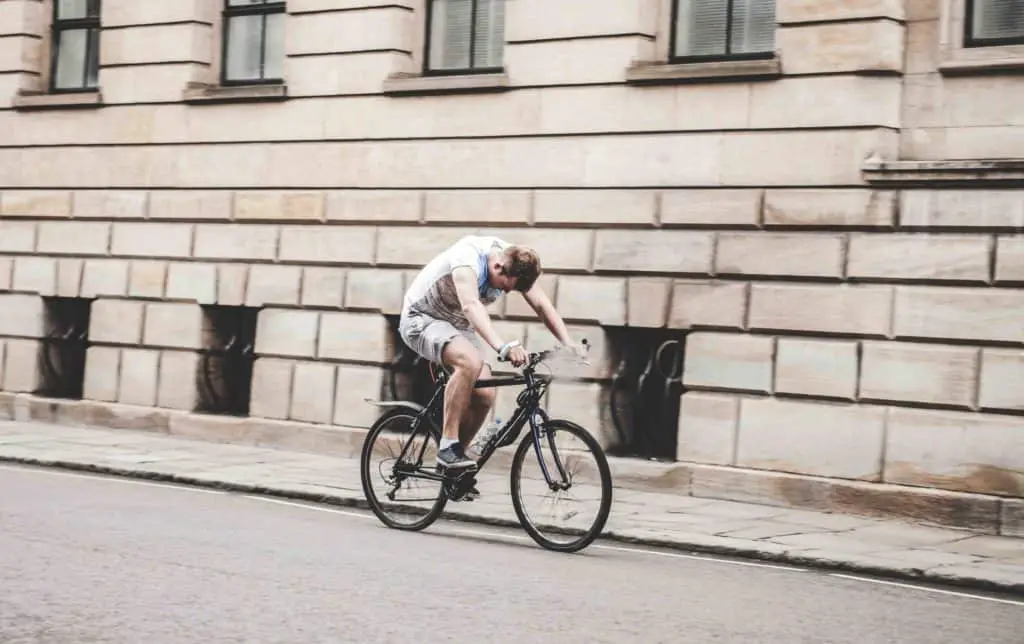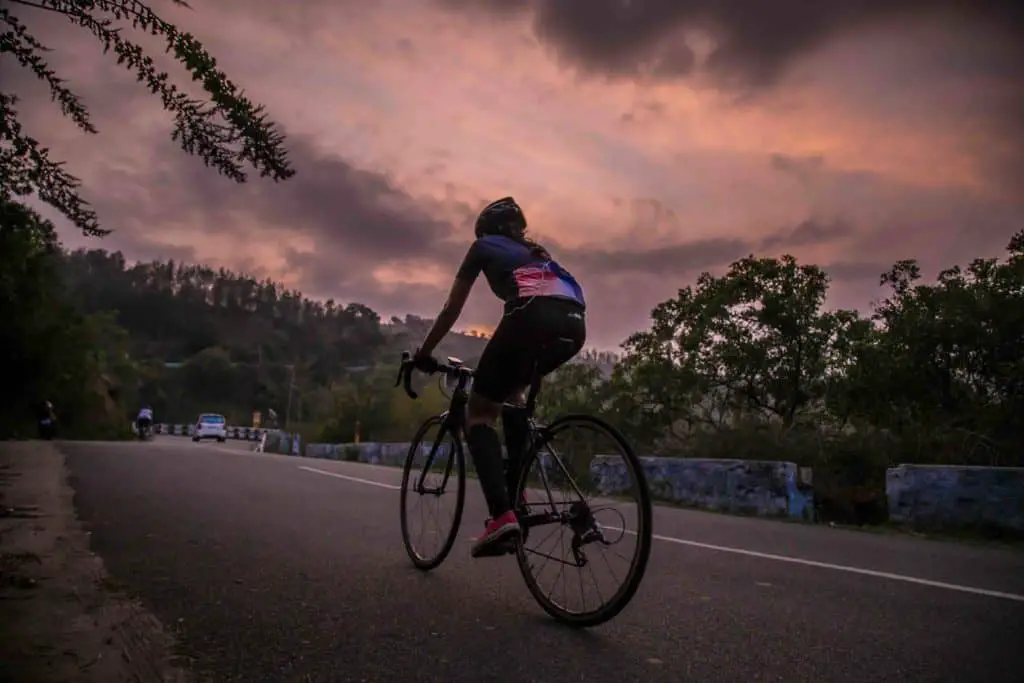
When many people think of low-impact exercising, their minds sometimes wander to cycling. While cycling is considered by many to be gentle on the joints, cyclists still sometimes experience that sharp pain in their knees. There are many different factors that can lead to achy knees while cycling, some of which can be corrected easily. We will explore down below why cycling knee pain occurs and what can be done to help lessen that pain.
Why Do Cyclists Experience Knee Pain?
You might feel like this is a loaded question, and you would be right. In fact, there are many different reasons why someone may be experiencing knee pain while cycling:
- Misaligned or worn cleats.
- Saddle misaligned or the height is not correct.
- No warm-up before the ride.
- Bicycle size not correct for the cyclist height.
- Wrong cycle positions.
These are considered the most common reasons, but there is much more to it. We will address them and further explain the motives and ways to deal with this issue.
You May Be Overdoing it

One of the main concerns surrounding cycling is that some people may tend to overdo it. This may be especially true for new cyclists who are just starting out and haven’t quite figured out their rhythm yet. Riding for extended periods of time or doing too much too quickly can lead to inflammation. This can cause your joints to feel sore, as well as potentially cause sharp pain.
Improper Form or Equipment

You have finally found a position that you like on the bike. You utilize this position daily and ride for extended periods of time. However, you notice that your knees are very sore afterwards. This may be because the position that you have landed on may not actually be good for your body type. The case may even be that the bike you have chosen is not ideal or a good fit for you either. Those who stick with the same position and do not tinker with what feels right for them, will typically experience more pain than those who listen to their body.
What are Knee Pain Symptoms?
Where you are experiencing your knee pain could help you in determining the root cause and help you to know how to remedy the situation. In general, those who are experiencing knee pain may feel sharp and stabbing pains around their knee joint. This may come and go or be a constant symptom when they are cycling. Some cyclists may notice that their knee pain only surfaces after they have been cycling for an extended period of time.
Pain in the Front of the Knee
Pain in the front of your knee, or your kneecap, is common among cyclists. This is because your kneecap is connected directly to your quads. Well-developed quad muscles are essential for adequate cycling, as this is what is used to pump you forward. However, straining your quads could cause increased stress on your kneecaps, which could result in pain. Narrowing down what is causing the pain, in relation to your bike, can be more difficult to track and may take some trial and error adjustments.
Tips to Help Alleviate This Pain
The overexertion of your quad muscles could cause this pain. Try to cut down on your intervals or give your legs more of a break between cycling sessions. Always make sure you are conditioned properly before you take on a hard sprint. This pain could also be related to the saddle of your bike sitting too low, which would affect the angle of your knees. Try adjusting the height or your saddle and making it taller. Your saddle may also be positioned too far forward, as this can also negatively affect the angle or your knees. If you want to know exactly where to place your saddle for your body, you should visit a professional cycling shop for expert advice.
Pain in the Back of the Knee
While this type of pain is less common than the front of the knee, it has still been known to affect cyclists. However, the main culprit of this type of pain is improper saddle height. Your knee being overextended could cause pain in the back of your knee, as your leg is not at the proper angle to eliminate pain. Take into account your handle bars, as this will help you adjust your saddle height. Overstrain on your legs can also cause this type of pain.
Tips to Help Alleviate This Pain
Try adjusting your saddle if you are experiencing pain at the back of your knee. You do not want your legs to be too overextended or too bunched up. Finding a happy medium may take some time. However, you could always talk to a professional to get an expert opinion on your form. This type of pain is usually due to the saddle being too high up or too far back. So, try repositioning the saddle to be lower than it is or a little bit further forward.
Pain on the Inside of the Knee
If you are feeling pain on the insides of your knees, you may think that the culprit is your legs. However, it is most likely due to the placement of your feet. If your cleats are too far inwards, this can cause increased strain on the ligaments that are located on the insides of your knees. Worn out cleats may also contribute to poor positioning and thus aggravate this symptom.
Tips to Help Alleviate This Pain
Consider your cycling shoes. Are they a good fit? Are the cleats in good shape? Take into account how your cleats are positioned in relation to your cycling shoes. You will want the relation of your knees to your pedals in vertical motion. The knee should not be moving too much inward or outward, as this can place stress on the knees and cause cycling knee pain.
Pain on the Outside of the Knee
Stress and inflammation of ligaments and connective tissue can lead to pain on the outside of the knee. This can happen when the cleats are not placed properly in relation to your feet. This can typically occur when your stance is too narrow atop your bike.
Tips to Help Alleviate This Pain
Misaligned cleats can create a lot more damage than you may be aware of. Try repositioning your feet and your cleats so that you can find a happy balance. If you are unsure of how your legs should be positioned, consult an expert at a professional shop. In general, you do not want any outward or inward motion of your knees.
How to Prevent Knee Pain
Even though knee pain is a common occurrence among cyclists, there are ways that you can help to reduce the pain and even prevent it from happening. Persistent knee pain that does not improve with adjustments will need to be seen by a medical professional to rule out any underlying conditions.
Always do a Warm-Up

Warming up your body before any kind of physical activity is always advised. This helps to not only get the blood flowing, but could also help to prevent possible injury. Warming up typically includes stretching your muscles and engaging in light exercise to help prepare you for your cycling session. Although warm up times can vary per individual, a good time to shoot for is 15 minutes.
Focused Knee Strengthening Exercises
If you are an avid cyclist, there are some specific stretches to help you deal with cycling knee pain. These stretches reduce inflammation, as well as warm-up your muscles to help prevent injury. Along with your daily warm-up sequence, here are some examples which you can add so you work on your knee strengthening:
Lunges

Lunges are great for those who are looking into knee strengthening exercises. In order to perform it, you will need to stand up straight with your legs together. Put one leg out in front of the other one and dip down. You will want to make a 90-degree angle with the leg that has been put out, but also do not allow your back leg to touch the floor. This will allow you to not only stretch out your legs, but you will also engage your core.
Leg Extensions

For leg extensions, you will want to lay on your back and bring your legs up to a 90-degree angle. Moving both of your legs at the same time and keeping them hip-length apart, push them out from your body. You will feel this movement in your legs and your back.
Build Yourself Up Gradually
Don’t attempt to tackle everything all at once. Also, don’t expect to become a professional overnight. Pushing yourself to do too much too soon can result in severe injuries and even prevent you from reaching your milestones. Set reasonably obtainable goals that do not cause you to overdo it. Increase your mileage gradually over time and you will typically see better results.
Try to Remain Consistent

With cycling, consistency is key. However, sometimes change is necessary in order to avoid injury and give yourself the best experience. When change occurs, even when necessary, your body will need some time to adapt to these changes.
Keep Yourself Warm
Even though you are going to be active, you still want to ensure that you are keeping yourself warm. You do not want to allow your knees to be exposed to cold air or the elements. So, ensure that below around 60 degrees you have coverings for your knees.
Get a Bike Fitting
You may want to consider getting a professional bike fitting to ensure that you have the proper fit for your body. This should be a professionally trained bike fitter that is knowledgeable on saddle heights, cleats, and leg angles. While this is an investment, it is typically well worth the purchase as then you are aware of these factors that may contribute to cycling knee pain.
Visiting a Bike Fitter or a Medical Expert
There is, oftentimes, only so much we can learn from the internet before we have to visit someone in person to help us sort out our health issues and associated knee pain. Knee pain can come from a lack of strength, flexibility, or even an improper bike fit. It is important to take all these considerations into account when you are attempting to determine a solution. Visiting with a medical professional, such as a physiotherapist, can also help you understand more about your body and how to position yourself better individually.
Moving on, with solutions
Anyone who cycles, whether they are a professional or not, does not want to experience any discomfort while at it. Even though knee pain is something common, it is not a comfortable occurrence and can potentially lead to injury if overlooked. It is important that if you are experiencing knee pain that you make the proper adjustments to your bike, your riding equipment as well as trying to understand the core of the pain to find solutions. By doing so you can ensure you are doing what is best for your body, so you keep enjoying the ride.

